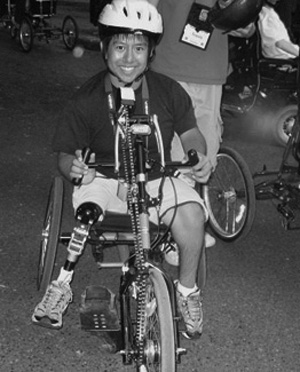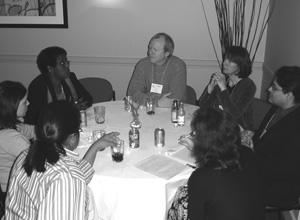Introduction to Capacity Building

Federal legislation mandates that no otherwise qualified individuals with disabilities shall, solely by reason of their disabilities, be excluded from the participation in, be denied the benefits of, or be subjected to discrimination in public programs and services in the United States, unless it would pose an undue burden to do so. This means that postsecondary courses, programs, and services must be accessible to qualified individuals.
Specifically, Section 504 of the Rehabilitation Act of 1973 mandates such access within institutions that receive federal funds. The Americans with Disabilities Act (ADA) of 1990 reinforces and extends access requirements to covered entities, regardless of their funding sources. However, individuals with disabilities are underrepresented in the group of individuals who participate in postsecondary education, earn degrees, and transition to successful careers (Blackorby & Wagner, 1996; National Council on Disability of Social Security Administration, 2000; National Organization on Disability, 2004; Wagner, Newman, Cameo, & Levine, 2005).
Efforts toward making a postsecondary institution more welcoming and accessible to people with disabilities can be made by faculty, administrators of student service organizations, and other staff (DO-IT, 2007). But change for any institution can be difficult.
What are the Motivations, Objectives, and Processes for Systemic Change?
Change can be viewed from three perspectives: the reason for change, the content of change, and the process of change (Levy & Merry, 1986).
Reason for Change
Individuals as well as entire institutions may experience both internal and external pressure for change (Levin, 1998). Internal factors that might promote positive change include placing a high value on diversity and educational equity (Oliver & Barnes, 1998) and seeing individuals with disabilities as a minority group with civil rights instead of a needy population deserving charity. These factors can motivate faculty and staff to increase the accessibility of their courses and services once they become aware of accessibility barriers and accessible design strategies. Although these individuals may be motivated to learn new skills and gain knowledge that will enhance student access, a competing motivation may be the comfort and efficiency of maintaining existing standards and procedures.
Knowledge of disability-related legislation will provide external motivation for change only if the individual makes the connection between this legislation and his/her practices and responsibilities. Another promoter of change for an individual is the existence of institutional policies relative to the accessibility of courses and services. An individual with a disability who requests accommodations may motivate a faculty or staff member to help this person, but may not provide the motivation to change future practices.
Lack of time and funding are common reasons for not making programs and courses more accessible. These factors often have as their root a lack of information about how to go about making a change or looking at accessibility as a huge project rather than an ongoing effort accomplished in incremental steps.
Content of Change
Many faculty and staff are unaware of the need for accessible design and, after becoming aware, perceive that they do not have the expertise or time to deal with accessibility issues. The two negative motivational factors of lack of prerequisite knowledge and time to implement accessibility measures might be addressed by providing specific, readily-achievable suggestions that apply principles of universal design to improve accessibility and resources specifically designed for faculty and staff. They should include introductory training materials as well as searchable, detailed content (Burgstahler, 2002, 2005).
Process of Change
Members of the AccessCollege team and those of earlier DO-IT projects determined that effective outreach efforts include on-site training as part of regularly scheduled and stand-alone meetings, video presentations, short informational handouts, and comprehensive web resources and searchable knowledge bases. To promote systemic change toward a more accessible campus, the AccessCollege team developed Communities of Practice (CoPs) and Capacity-Building Institutes (CBIs).
On What Research Can Our Professional Development Rest?
DO-IT has created literature reviews that can help guide professional development of faculty (https://www.washington.edu/doit/synthesis-research-0) and student services personnel (https://www.washington.edu/doit/synthesis-research). Research syntheses support training strategies and materials and include the topics of adult learning, learning styles, types of learning, universal design, and systemic change. These materials were created in earlier projects as part of the following publications:
- Building the Team: Faculty, Staff, and Students Working Together—PRESENTATION AND RESOURCE MATERIALS
- Students with Disabilities and Campus Services: Building the Team—PRESENTATION AND RESOURCE MATERIALS
The content and methods for professional development include Communities of Practice and Capacity-Building Institutes. These platforms for growth are discussed in the following paragraphs, can be used to further your agenda for creating a campus that is more welcoming and accessible to people with disabilities.
How Can Universal Design Help Us Focus on Our Systemic Change Efforts?
Universal design strategies can help you create products and environments that are welcoming and accessible to all students, staff, faculty, and visitors on your campus. Universal design (UD) can be applied to instruction, services, information technology, and physical spaces, as noted below.
Instruction
- Class Climate
- Physical Environments/Products
- Delivery Methods
- Information Resources/Technology
- Interaction
- Feedback
- Assessment
- Accommodation
Services
- Planning, Policies, and Evaluation
- Physical Environments/Products
- Staff
- Information Resources/Technology
- Events
Information Technology
- Procurement/Development Policies
- Physical Environments/Products
- Information
- Input/Control Output
- Manipulations
- Safety
- Compatibility with Assistive Technology
Physical Spaces
- Climate, Aesthetics
- Entrances and Routes of Travel
- Fixtures, Furniture
- Information Resources/Technology
- Safety
- Accommodation
Universal Design in Education (UDE):
- puts high values on both diversity and inclusion
- rests on the definition and principles developed at the Center for Universal Design, www.design.ncsu.edu/cud
- makes products and environments welcoming, accessible, and usable by everyone
- is a process as well as a set of guidelines and strategies for specific applications.
- can be implemented in incremental steps. (Burgstahler, 2007a-e)
For more information about UDE, consult The Center for Universal Design in Education.
What is a Community of Practice?

CoPs are groups of people who share a common concern in their practice and interact regularly to improve their practice. CoPs identify problems, goals, and resources; assess change; and monitor and adjust plans and activities.
Team members in the AccessCollege project created CoPs on their own campuses and encouraged partner schools to do the same. Some meet in person; some meet online or by telephone; others meet in multiple ways. As with any CoP, each has chosen:
- a domain of interest that is related to the goals of AccessCollege (e.g., professional development of faculty, information technology policies and procedures, campus-wide efforts to promote universal design of courses and services);
- a group of people, including practitioners interested in furthering accessibility policy and practice within the CoP domain, sharing perspectives and expertise, identifying promoters and inhibitors of change, setting goals, and identifying projects; and
- practices undertaken to further goals identified by CoP members (Wenger, 1998).
CoPs host Capacity-Building Institutes, which draw in other members of on- and off-campus stakeholder groups to identify barriers for people with disabilities and strategies for promoting the universal design of courses and services on campus. Synthesis of input from CBIs further informs CoPs as members work toward campus improvements.
What is a Capacity-Building Institute?
Capacity-Building Institutes (CBI) bring people together to collaboratively identify solutions to specific problems. Participants may come from across disciplines, departments, and/or institutions. A CBI builds the capacity of each member of the group and their respective organizations to solve identified problem(s) and to explore ways that other individual or organizational stakeholders can contribute to solution(s).
The strength of a CBI is in the way people who may not typically work together converge to expand collective knowledge and develop strategies to address a common goal. Examples of goals that CBI participants can address are:
- improving the overall accessibility of a postsecondary institution to people with disabilities
- applying universal design of instruction campus-wide
- assuring that information technology is accessible to all faculty, staff, and students